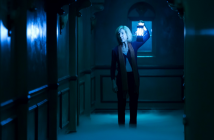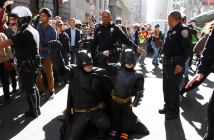
Editor’s Notes: The Walk opens in IMAX 3D today, September 30th, and on October 9th in regular 2D and 3D.
The Walk is a superb end-of-summer popcorn flick. It is able to truly use the tools and techniques of modern computer-generated imagery so that they heighten the emotions of the story on screen. In this age of Marvel Mania, true action-adventure spectacle is rare. Today, CG technology has become cinema’s greatest blight, because it exists in excess and to simply serve itself and ADD fanboys. In mechanical fashion, explosions, high-speed superheroes, and rays of plasma scatter rapidly across the screen without pattern or symmetry. These superhero movies become optical nightmares, busying our eyes and shattering our persistence of vision and sense of surprise.
It is able to truly use the tools and techniques of modern computer-generated imagery so that they heighten the emotions of the story on screen.
As a visual experience, The Walk is bar none. Director Robert Zemeckis (also co-writer and producer) pulls off several feats of spectacular imagery here. His CG shots work because they have a clear focal point, thus properly guiding the audience’s gaze. Take the moment when a steel rope’s clamp falls right toward centre frame; it stops and stays in focus. Above, out of focus, the North and South World Trade Center towers support it by a thread. From where the camera’s mounted (if this were done without CGI), there would be about another 600 feet below it. To viewers, it looks too real; anxiety envelops our thoughts of what is outside or, more accurately, below the frame (acrophobic viewers, take note!).

With all of this description, I have not even mentioned the story. It is, of course, a dramatization of Philippe Petit (played by Joseph Gordon-Levitt) and his high-wire walk between the old Twin Towers of New York City. The year was 1974 and the towers were nearly finished construction. Petit had walked the Notre Dame cathedral (shown in this film) and the Sydney Harbour Bridge (not shown), but the Twin Towers was his (American) dream. As a Parisian entertainer, he wanted to travel to America and perform what would be known as his “coup”, which involved infiltrating the building as construction workers. The coup started August 6th and was completed the morning of the 7th. The walk itself last about 45 minutes.
Co-writers Christopher Browne and Zemeckis smartly base the screenplay around Petit’s aspirations. All the remaining elements - from the supporting characters to the 3D spectacle - inform Petit’s psychological drive. That sensibility is what buoys the film; when Zemeckis cuts to a POV of Petit looking at the ground 1300 feet below, we immediately sympathize with our hero’s astonishment (Zemeckis doesn’t even to trick things up with a dolly zoom).
The supporting players, while underwritten, have charisma and fill their units in this delightful balancing act.
At 123 minutes, The Walk devotes little time to needless subplots; there is tremendous economy to the storytelling. When you expect events to sag, Zemeckis actually improves the pace. For instance, The Polar Express director makes inventive use of match cuts and dissolves to crosscut between Petit’s plan to infiltrate the towers to him and his crew’s actual execution of that plan. This sequence, like the others, is edited with speed and elegance. There is even a moment near the end of the film when Petit reimagines the steel fibres twisting into the wire that was once attached to both towers. The shot is not fanciful; it taps into Petit’s desire to be up on that rope and close to the heavens where he would be able “To Reach the Clouds” (as his book on this triumph would be called).
No, The Walk is not fanciful, it is fantastical. Told by Petit atop the Statue of Liberty (admittedly, a hokey device), The Walk unfolds with Levitt’s surprisingly believable Parisian accent (the actor is a known francophile) providing upbeat voiceover. The voiceover gives The Walk almost a fairy tale vibe, like it is being riddled out by a very enthusiastic storytelling who knows how to modulate and play up his fear and excitement for our amusement. While the movie could have worked without it, the voiceover creates this sensation of an awe-inspiring tale being told to us. We are supposed to feel like one of the lucky few who get to witness it.
The supporting players, while underwritten, have charisma and fill their units in this delightful balancing act. Ben Kingsley plays Papa Rudy, a surly circus showman who mentors Petit. French-Canadian actress Charlotte Le Bon is endearing as Petit’s love interest, Annie, whose encouragement and loyalty give Petit the strength to pull off this daring, quarter-mile-high feat. James Badge Dale is also memorable as JP, a French-speaking techie who smooth talks the group’s way into the building.
Naturally, the last act is all Petit as he, holding a balancing pole, maneuvers back and forth from the towers. Zemeckis’s style never grows repetitious and he always finds ways to upend our stomachs with vertiginous (but awe-inspiring) p.o.v. shots and camera moves that would not be possible without today’s technology. There is also a tremendous amount of suspense for a story most of us are familiar with (see 2008’s great Man On Wire).
The Walk is, simply, an immersive experience. It is not a dark and probing drama like Sicario, and it does not want to be. Zemeckis has found a way to use CGI so that it offers insight into a character’s psychology and point-of-view, instead of just pandering to empty scale. The movie offers heightened emotion and doesn’t come off as a hollow theme park ride (I’m looking at you, Gravity). The Walk is one of the better pure entertainments of the year.
The Walk is great spectacle, but also the kind that offers some real emotional pull and visceral amazement. Levitt is charismatic as the wry tightrope wizard Philippe Petit, and Robert Zemeckis’s assured direction generates easy immersion for the viewer. A welcoming elixir to yet another year of tasteless Marvel movies.




Pingback: www.streetfire.net()